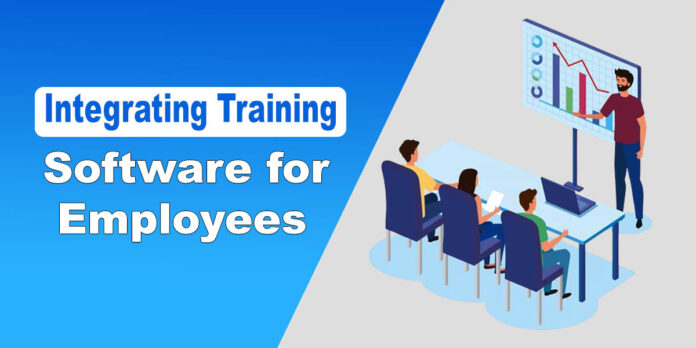Maintaining productivity and simplifying business processes within an organization requires integrating employee training software with other platforms. Businesses can enhance employee onboarding, training, and development procedures by smoothly integrating different platforms.
In this blog post, we will examine the advantages of connecting employee training software with other systems and offer insightful advice on how to do this integration successfully.
Why Use Training Software Integration?
There are several benefits businesses can enjoy as a result of this integration; some of them are:
1. Enhanced Data Management
Centralized data management is made possible through the integration of training software for employees with other systems. An integrated system makes sure that all data is synchronized and up to date in real-time, saving you the trouble of juggling numerous platforms and manually transferring data between them. This makes reporting, analysis, and progress tracking easier and more efficient.
2. Streamlined Onboarding
Effective onboarding of new hires is essential for increasing engagement and laying the groundwork for future success. New hires can easily access process guidelines, orientation materials, and compliance documentation from a single platform with integrated training software. By doing so, administrative costs are decreased, and a uniform onboarding process is guaranteed. This ensures new workers can easily understand their duties and business processes to increase business productivity.

3. Improved Training Delivery
Businesses can make better use of their current infrastructure to deliver training programs by integrating training software with other systems. For example, employees can access courses and instructions directly from within their workflow by integrating with learning management systems (LMS), saving them the trouble of moving between various programs. Integration can also make automated enrolment based on job titles or staff roles possible. As a result, a business needs to spend less resources and time on employee training to increase ROI and bottom line too.
Key Systems That Can Be Integrated
1. Human Resources Information System (HRIS)
By integrating training software with HRIS, it is possible to automate various operations associated with training development or implementation and to consolidate employee profiles. For instance, when a job function changes, training assignments or personalized learning paths based on personal objectives are instantly updated.
2. Learning Management Systems (LMS)
Employee progress is consistently tracked throughout their careers when learning management systems (LMS) are integrated with larger learning ecosystems or talent management suites, such as performance management systems or career development tools. This offers insightful information for performance reviews and career growth planning.
3. Communication and Collaboration Tools
The integration of training software with communication and collaboration tools, like chat applications, project management platforms, and intranets, can improve employee engagement, facilitate peer-to-peer learning, and improve access to training resources. Even if they are geographically separated, employees can engage with trainers and take part in virtual classrooms with ease.
Best Practices for Successful Integration
1. Clearly Define Objectives and Evaluate Systems
Setting specific goals is essential before starting the integration process. Determine what parts of your training course can be improved by integrating it with other systems. Consider your particular needs and the compatibility of the different software solutions on the market while evaluating them. You should also assess your current systems and their features to determine what you can achieve with this integration.
2. Align Stakeholders
All parties involved in an integration project must work together to ensure its success, including end users, IT staff, HR departments, and trainers. Early on in the process, involve all pertinent parties to learn about their requirements and expectations for integrated training software. Keep them all on the same page to ensure everyone is aware of the entire process and how it will contribute to business growth.
Read Also: Challenges Your Tech Startup Will Face
3. Leverage Standard APIs
Effective system integration is largely dependent on Application Programming Interfaces, or APIs. Make sure the software solutions you’ve chosen have reliable APIs that facilitate easy data transfer between systems. This ensures a smooth integration process without facing any kind of downtime.
4. Prioritize Data Security
Integration needs to happen while following strict data security guidelines. Protect sensitive employee data when it moves across systems by implementing secure protocols like as single sign-on (SSO) authentication techniques or encrypted connections. You should also check the security of other systems included in the integration process.
5. Support Change Management
Employees may need to adopt new procedures or modifications to current workflows as a result of the integration process. To promote a successful adoption during this transitional phase, proactively and honestly convey these changes and offer sufficient training and assistance.
Final Words
Businesses can improve data management procedures throughout employees’ careers, streamline onboarding experiences, and increase the effectiveness of training delivery by connecting employee training software with other systems like HRIS, LMS, or communication tools.
To guarantee that objectives are sufficiently achieved, nevertheless, a thorough assessment of the software that is now accessible must be carried out and consensus among pertinent parties must be reached. It is important that businesses perceive integration as a strategic initiative that harmonizes training with fundamental business goals, with the ultimate aim of augmenting employee performance and engagement, rather than merely as a stand-alone IT project.
To fully reap the benefits of integrating training software, companies must commit time and resources to carefully assessing their goals, selecting suitable systems, giving data security top priority, assisting with change management, and closely working with all pertinent stakeholders. Businesses may build a seamless learning ecosystem that boosts productivity and enables staff members to reach their full potential by adhering to these best practices.

